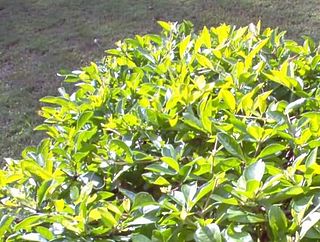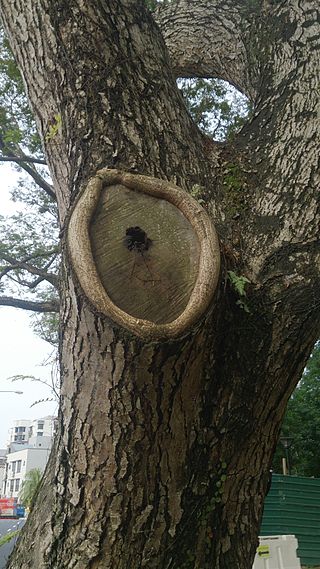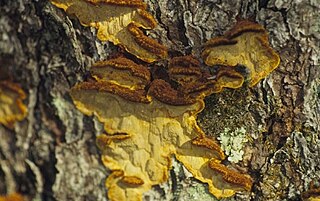This article needs additional citations for verification .(September 2010) |

Compartmentalization Of Decay In Trees (CODIT) is a model developed by plant pathologist Alex Shigo after studying wood-decay fungus patterns.
This article needs additional citations for verification .(September 2010) |

Compartmentalization Of Decay In Trees (CODIT) is a model developed by plant pathologist Alex Shigo after studying wood-decay fungus patterns.
In keeping with the theory of spontaneous generation, in which living things can develop from non-living things, scientists traditionally believed that tree decay led to fungal growth.[ citation needed ] With the advent of germ theory, however, German forester Robert Hartig in the early 20th century theorized the opposite was the case, and developed a new model for tree decay: when trees are wounded, fungi infect the wounds, and the result is decayed wood.
Shigo expanded this theory to claim that when trees are wounded, they respond to the infected wood with both chemical and physical changes to limit the decay, which he called compartmentalization.

According to CODIT, when a tree is wounded cells undergo changes to form "walls" around the wound, slowing or preventing the spread of disease and decay to the rest of the tree.
By increasing understanding of how trees respond to decay, CODIT has had many applications. For example, arborists are frequently called upon to analyze the danger posed to people or property by a damaged or decaying tree. By knowing how decay is likely to spread, such hazard tree analyses may be more accurate, thereby preventing unnecessary tree removal, property damage, or injury.[ citation needed ]
Work done by Dr. Edward F. Gilman at the University of Florida shows that a wound's proximity to leaf mass greatly influences compartmentalization as well as wound closure.[ citation needed ]

Wood is a structural tissue found in the stems and roots of trees and other woody plants. It is an organic material – a natural composite of cellulose fibers that are strong in tension and embedded in a matrix of lignin that resists compression. Wood is sometimes defined as only the secondary xylem in the stems of trees, or more broadly to include the same type of tissue elsewhere, such as in the roots of trees or shrubs. In a living tree it performs a support function, enabling woody plants to grow large or to stand up by themselves. It also conveys water and nutrients between the leaves, other growing tissues, and the roots. Wood may also refer to other plant materials with comparable properties, and to material engineered from wood, woodchips, or fiber.

Bark is the outermost layer of stems and roots of woody plants. Plants with bark include trees, woody vines, and shrubs. Bark refers to all the tissues outside the vascular cambium and is a nontechnical term. It overlays the wood and consists of the inner bark and the outer bark. The inner bark, which in older stems is living tissue, includes the innermost layer of the periderm. The outer bark on older stems includes the dead tissue on the surface of the stems, along with parts of the outermost periderm and all the tissues on the outer side of the periderm. The outer bark on trees which lies external to the living periderm is also called the rhytidome.

Pruning is a horticultural, arboricultural, and silvicultural practice involving the selective removal of certain parts of a plant, such as branches, buds, or roots.

Oak wilt is a fungal disease caused by the organism Bretziella fagacearum that threatens Quercus spp. The disease is limited to the eastern half of the United States; first described in the 1940s in the Upper Mississippi River Valley. The pathogen penetrates xylem tissue, preventing water transport and causing disease symptoms. Symptoms generally consist of leaf discoloration, wilt, defoliation, and death. The disease is dispersed by insect vectors and to adjacent trees through underground root networks. However, human spread is the most consequential dispersal method. Moving firewood long distances can potentially transport diseases and invasive species.

A leaf spot is a limited, discoloured, diseased area of a leaf that is caused by fungal, bacterial or viral plant diseases, or by injuries from nematodes, insects, environmental factors, toxicity or herbicides. These discoloured spots or lesions often have a centre of necrosis. Symptoms can overlap across causal agents, however differing signs and symptoms of certain pathogens can lead to the diagnosis of the type of leaf spot disease. Prolonged wet and humid conditions promote leaf spot disease and most pathogens are spread by wind, splashing rain or irrigation that carry the disease to other leaves.

In trees, heart rot is a fungal disease that causes the decay of wood at the center of the trunk and branches. Fungi enter the tree through wounds in the bark and decay the heartwood. The diseased heartwood softens, making trees structurally weaker and prone to breakage. Heart rot is a major factor in the economics of logging and the natural growth dynamic of many older forests. Heart rot is prevalent throughout the world affecting all hardwood trees and can be very difficult to prevent. A good indication of heart rot is the presence of mushrooms or fungus conks on the tree.

A branch collar is the "shoulder" between the branch and trunk of woody plants; the inflammation formed at the base of the branch is caused by annually overlapping trunk tissue. The shape of the branch collar is due to two separate growth patterns, initially the branch grows basipetally, followed by seasonal trunk growth which envelops the branch.

Nectria cinnabarina, also known as coral spot, is a plant pathogen that causes cankers on broadleaf trees. This disease is polycyclic and infects trees in the cool temperate regions of the Northern Hemisphere. N. cinnabarina is typically saprophytic, but will act as a weak parasite if presented with an opportunity via wounds in the tree or other stressors that weaken the tree's defense to the disease. A study published in 2011 showed that this complex consists of at least 4 distinct species. There are only a few ways to manage this disease with techniques such as sanitation and pruning away branches that have the cankers. N. cinnabarina is not as significant a problem as other Nectria spp., some of which are the most important pathogens to infect hardwood trees.

Lasiodiplodia theobromae is a plant pathogen with a very wide host range. It causes rotting and dieback in most species it infects. It is a common post harvest fungus disease of citrus known as stem-end rot. It is a cause of bot canker of grapevine. It also infects Biancaea sappan, a species of flowering tree also known as Sappanwood.

Penicillium expansum is a psychrophilic blue mold that is common throughout the world in soil. It causes Blue Mold of apples, one of the most prevalent and economically damaging post-harvest diseases of apples.
Alternaria citri is a fungal plant pathogen that causes black rot in citrus plants.

Porodaedalea pini, commonly known as the pine conk, is a species of fungus in the family Hymenochaetaceae. It is a plant pathogen that causes tree disease commonly known as "red ring rot" or "white speck". This disease, extremely common in the conifers of North America, decays tree trunks, rendering them useless for lumber. It is a rot of the heartwood. Signs of the fungus include shelf-shaped conks protruding from the trunks of trees. Spores produced on these conks are blown by the wind and infect other trees. Formal management of this disease is limited, and the disease is controlled primarily by cultural practices. Red ring rot is an important forest disturbance agent and plays a key role in habitat formation for several forest animals.

Diaporthe phaseolorum var. sojae is a plant pathogen infecting soybean and peanut.

In woody plants, a tylosis is a bladder-like distension of a parenchyma cell into the lumen of adjacent vessels. The term tylosis summarises the physiological process and the resulting occlusion in the xylem of woody plants as response to injury or as protection from decay in heartwood. It is a key process in wall one of the compartmentalization of decay in trees (CODIT) and other woody plants.

Bacterial soft rots are caused by several types of bacteria, but most commonly by species of gram-negative bacteria, Erwinia, Pectobacterium, and Pseudomonas. It is a destructive disease of fruits, vegetables, and ornamentals found worldwide, and affects genera from nearly all the plant families. The bacteria mainly attack the fleshy storage organs of their hosts, but they also affect succulent buds, stems, and petiole tissues. With the aid of special enzymes, the plant is turned into a liquid mush in order for the bacteria to consume the plant cell's nutrients. Disease spread can be caused by simple physical interaction between infected and healthy tissues during storage or transit. The disease can also be spread by insects. Control of the disease is not always very effective, but sanitary practices in production, storing, and processing are something that can be done in order to slow the spread of the disease and protect yields.

Armillaria root rot is a fungal root rot caused by several different members of the genus Armillaria. The symptoms are variable depending on the host infected, ranging from stunted leaves to chlorotic needles and dieback of twigs and branches. However, all infected hosts display symptoms characteristic of being infected by a white rotting fungus. The most effective ways of management focus on limiting the spread of the fungus, planting resistant species, and removing infected material. This disease poses a threat to the lumber industry as well as affecting recreational areas.
Leucostoma canker is a fungal disease that can kill stone fruit. The disease is caused by the plant pathogens Leucostoma persoonii and Leucostoma cinctum (teleomorph) and Cytospora leucostoma and Cytospora cincta (anamorphs). The disease can have a variety of signs and symptoms depending on the part of the tree infected. One of the most lethal symptoms of the disease are the Leucostoma cankers. The severity of the Leucostoma cankers is dependent on the part of the plant infected. The fungus infects through injured, dying or dead tissues of the trees. Disease management can consist of cultural management practices such as pruning, late season fertilizers or chemical management through measures such as insect control. Leucostoma canker of stone fruit can cause significant economic losses due to reduced fruit production or disease management practices. It is one of the most important diseases of stone fruit tree all over the world.

Phomopsisblight of juniper is a foliar disease discovered in 1917 caused by the fungal pathogen Phomopsis juniperovora. The fungus infects new growth of juniper trees or shrubs, i.e. the seedlings or young shoots of mature trees. Infection begins with the germination of asexual conidia, borne from pycnidia, on susceptible tissue, the mycelia gradually move inwards down the branch, and into the main stem. Management strategies mainly include removing and destroying diseased tissue and limiting the presence of moisture on plants. Junipers become resistant to infection as they mature and the young yellow shoots turn dark green. Preventive strategies include planting only resistant varieties and spraying new growth with fungicide until plants have matured.

Pine-pine gall rust, also known as western gall rust, is a fungal disease of pine trees. It is caused by Endocronartium harknessii, an autoecious, endocyclic, rust fungus that grows in the vascular cambium of the host. The disease is found on pine trees with two or three needles, such as ponderosa pine, jack pine and scots pine. It is very similar to pine-oak gall rust, but its second host is another Pinus species. The fungal infection results in gall formation on branches or trunks of infected hosts. Gall formation is typically not detrimental to old trees, but has been known to kill younger, less stable saplings. Galls can vary from small growths on branch extremities to grapefruit-sized galls on trunks.
Aspen trunk rot is a fungal disease that causes stem decay heart rot of living aspen trees. The pathogen that causes this disease is the fungus Phellinus tremulae. Most of the symptoms of this disease are internal, with the only external signs of a diseased aspen being fruiting bodies called conks. A single conk found on an aspen can indicate advanced decay of up 82% of the tree volume. Internal decayed wood of freshly cut aspens is spongy, yellow/white colored, surrounded by black zones of discoloration, and contains a distinct wintergreen smell. The fungus is spread via airborne spores released from the fruiting body which can infect through dead branches, branch stubs, or wounds in the tree. Although no direct management control is known, harvesting aspen stands that have been damaged or harvesting stands before decay becomes advanced minimizes tree loss. Aspen wood is white, malleable but strong, and heat-tolerant and therefore has many commercial uses including matches, packing paper, lumber, plywood, pulp, and animal beds. Aspen trees diseased with aspen trunk rot decrease the economic value of the lumber.